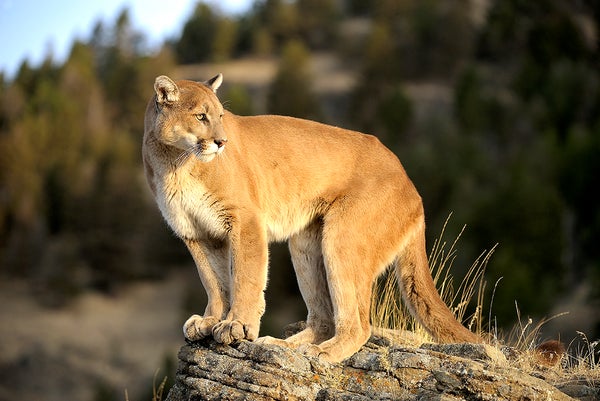Humans kill large carnivores—a category of animals that includes wolves, bears, lions, tigers and pumas—at more than nine times their mortality rate in the wild. Although they may not be our prey in the traditional sense, new research shows that some of the world's biggest carnivores are responding to humans in a way that resembles how prey animals react to predators. Biologists at the Santa Cruz Puma Project, an ongoing research effort in the mountains of California's central coast, report that even the formidable puma, or mountain lion, shows its fearful side when people are around.
In a recent study, the researchers followed 17 mountain lions outfitted with GPS collars to the animals' deer kill sites. Once the cats naturally left the scene between feedings, ecologist Justine A. Smith, now at the University of California, Berkeley, and her team trained motion-activated cameras on the prey carcasses. On the animals' return, the cameras triggered nearby speakers, which broadcast recordings of either frogs croaking or humans conversing.
The pumas almost always fled immediately on hearing the human voices, and many never returned to resume feeding or took a long time to do so. But they only rarely stopped eating or fled when they heard the frogs. They also spent less than half as much time feeding during the 24 hours after first hearing human chatter, compared with hearing the frogs, the team reported this year in the Proceedings of the Royal Society B.
On supporting science journalism
If you're enjoying this article, consider supporting our award-winning journalism by subscribing. By purchasing a subscription you are helping to ensure the future of impactful stories about the discoveries and ideas shaping our world today.
The human presence in such a situation has far-reaching consequences. A previous study found that Santa Cruz pumas living near residential areas killed 36 percent more deer than those in less populated places. The new finding could explain why: if the cats are scared away from their kills before they finish feeding, they may be taking more prey to compensate. And fewer deer could mean more plants go uneaten, according to Chris Darimont, a professor of conservation science at the University of Victoria in British Columbia, who was not involved in the study. Thus, fear of humans may alter the entire food chain.
“Humans are the most significant source of mortality for pumas in this population even though [the cats are] not [legally] hunted” for food or sport, Smith says. Many are hunted illegally, struck by vehicles or legally killed by governmental agencies as a means of protecting livestock. “So they have good reason to be fearful of us,” she adds. Darimont predicts other large carnivores would show similar responses because humans have effectively become the planet's apex predators—even if we often do not eat what we kill. “I expect this to be common because the human predator preys on just about every medium-to-large vertebrate on the planet,” he says. “And at very high rates.”
